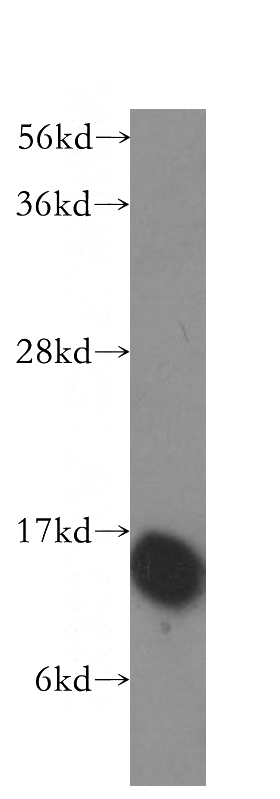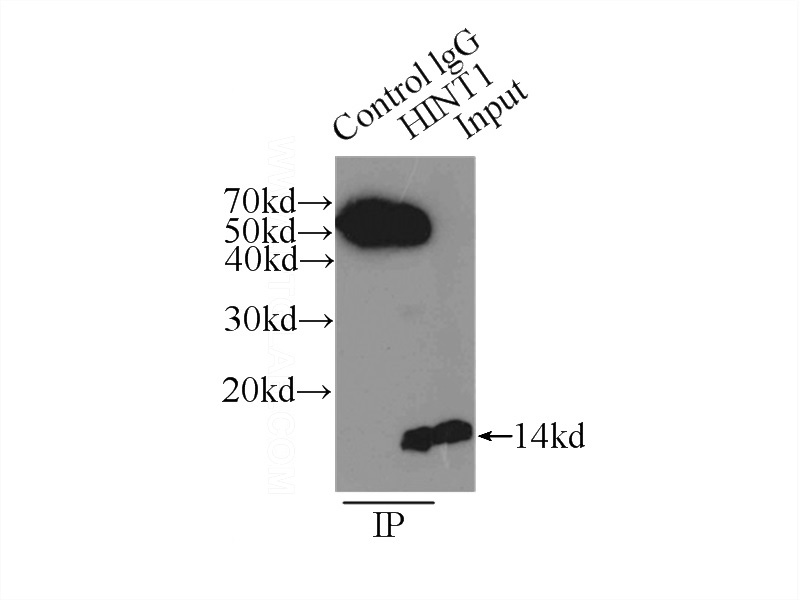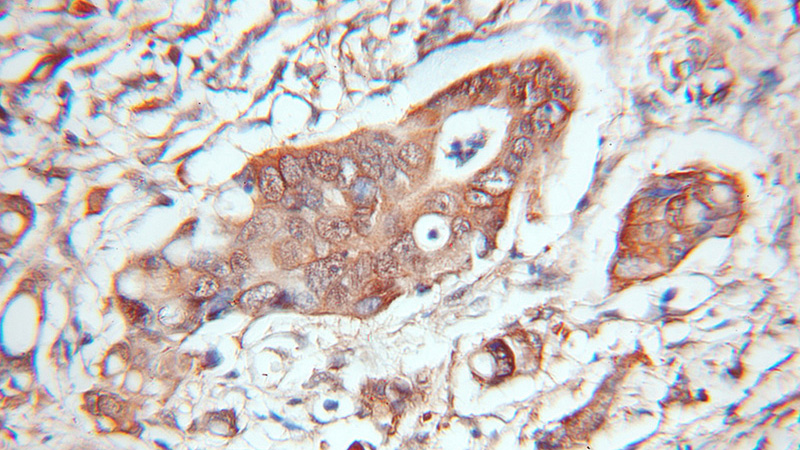-
Product Name
HINT1 antibody
- Documents
-
Description
HINT1 Rabbit Polyclonal antibody. Positive IHC detected in human colon cancer tissue. Positive WB detected in HEK-293 cells, K-562 cells, Raji cells, rat brain tissue, rat thymus tissue. Positive IP detected in mouse brain tissue. Observed molecular weight by Western-blot: 14 kDa
-
Tested applications
ELISA, WB, IHC, IP
-
Species reactivity
Human,Mouse,Rat; other species not tested.
-
Alternative names
FLJ30414 antibody; FLJ32340 antibody; HINT antibody; HINT1 antibody; PKCI 1 antibody; PKCI1 antibody; PRKCNH1 antibody; Protein kinase C inhibitor 1 antibody
- Immunogen
-
Isotype
Rabbit IgG
-
Preparation
This antibody was obtained by immunization of HINT1 recombinant protein (Accession Number: NM_005340). Purification method: Antigen affinity purified.
-
Clonality
Polyclonal
-
Formulation
PBS with 0.1% sodium azide and 50% glycerol pH 7.3.
-
Storage instructions
Store at -20℃. DO NOT ALIQUOT
-
Applications
Recommended Dilution:
WB: 1:500-1:5000
IP: 1:200-1:2000
IHC: 1:20-1:200
-
Validations

HEK-293 cells were subjected to SDS PAGE followed by western blot with Catalog No:111351(HINT1 antibody) at dilution of 1:400

IP Result of anti-HINT1 (IP:Catalog No:111351, 3ug; Detection:Catalog No:111351 1:500) with mouse brain tissue lysate 7500ug.

Immunohistochemical of paraffin-embedded human colon cancer using Catalog No:111351(HINT1 antibody) at dilution of 1:100 (under 10x lens)
-
Background
HINT1(Histidine triad nucleotide-binding protein 1) is also named as HINT, PKCI1, PRKCNH1,which is a member of the histidine triad (HIT) family, highly conserved in diverse species and ubiquitously expressed in mammalian tissues.It hydrolyzes adenosine 5'-monophosphoramidate substrates such as AMP-morpholidate, AMP-N-alanine methyl ester, AMP-alpha-acetyl lysine methyl ester and AMP-NH2.This antibody is specific to HINT1.
-
References
- Cen B, Li H, Weinstein IB. Histidine triad nucleotide-binding protein 1 up-regulates cellular levels of p27KIP1 by targeting ScfSKP2 ubiquitin ligase and Src. The Journal of biological chemistry. 284(8):5265-76. 2009.
- Ho J, Kong JW, Choong LY. Novel breast cancer metastasis-associated proteins. Journal of proteome research. 8(2):583-94. 2009.
- Berglund SR, Santana AR, Li D, Rice RH, Rocke DM, Goldberg Z. Proteomic analysis of low dose arsenic and ionizing radiation exposure on keratinocytes. Proteomics. 9(7):1925-38. 2009.
- Zhang YJ, Li H, Wu HC. Silencing of Hint1, a novel tumor suppressor gene, by promoter hypermethylation in hepatocellular carcinoma. Cancer letters. 275(2):277-84. 2009.
- Hsieh SY, Hsu CY, He JR. Identifying apoptosis-evasion proteins/pathways in human hepatoma cells via induction of cellular hormesis by UV irradiation. Journal of proteome research. 8(8):3977-86. 2009.
- Jackson KJ, Chen Q, Chen J, Aggen SH, Kendler KS, Chen X. Association of the histidine-triad nucleotide-binding protein-1 (HINT1) gene variants with nicotine dependence. The pharmacogenomics journal. 11(4):251-7. 2011.
- Murakami E, Tolstykh T, Bao H. Mechanism of activation of PSI-7851 and its diastereoisomer PSI-7977. The Journal of biological chemistry. 285(45):34337-47. 2010.
- Genovese G, Ghosh P, Li H. The tumor suppressor HINT1 regulates MITF and β-catenin transcriptional activity in melanoma cells. Cell cycle (Georgetown, Tex.). 11(11):2206-15. 2012.
Related Products / Services
Please note: All products are "FOR RESEARCH USE ONLY AND ARE NOT INTENDED FOR DIAGNOSTIC OR THERAPEUTIC USE"
